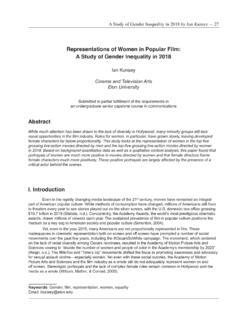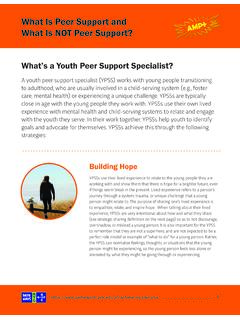Transcription of Villains: (Re)presentations of the Bad Guy
1 Villains: (Re)presentations of the Bad Guy Bridgett Orgain Introduction Children's movies are filled with two key ingredients: heroes and villains. While the subject of heroes has been frequently addressed in elementary curriculum (Alvermann & Hagood 1999), the idea of villains has not been thoroughly explored or included in elementary curriculum. In the same manner that heroes help normalize what is considered good and right, representations of villains determine what is bad and wrong. Within the genre of villainy, there exist stereotypes of villains as evil, old (Robinson & Anderson 2006), and queer (Li-Vollmer &. LaPointe 2003). Students need to critically engage with the genre of villains to recognize those stereotypes. In the lower elementary grades, students are also becoming a part of school culture. Already they understand the difference between good and bad behavior as defined by teachers, principles, and parents and are constructing their identity according to these hegemonic rules.
2 A. reinvestigation of villains is an opportunity for students to participate in transgressive pedagogy (Duncum 2009) and experience permutable identity (Richards 2007) even the identity of the bad guy . Within the school culture, good and bad are presented as binaries. This curriculum on villains allows students to see that there are often shades of gray in-between. Villains: the good, the bad, the ugly In the simplest form, the villain is the bad guy the antithesis to the hero. However, the stereotype of villain as evil has been played out so often that a new bad guy has come on to the scene. In the words of Wreck-It Ralph, I'm bad, and that's good. I will never be good, and that's not bad. There's no one I'd rather be then me (Spencer & Moore, 2012). A bad guy that isn't a bad guy is the premise of several blockbuster films within the past few years, such as Wreck-It Ralph (Spencer & Moore, 2012), Megamind (Breay, L.)
3 , Cascino, D. N., &. McGrath, T., 2010), and Despicable Me (Cohen, J., Healy, J., Coffin, P., & Renaud, C., 2010). These movies suggest the villains are misunderstood instead of evil victims of their situation that aren't all bad. As Marriner (2011) describes, Far from one dimensional baddies, the self-styled sinister protagonists in these films are intriguing and complex characters who look meaner than they really are (p. 16). These misunderstood villains fall between the binaries of good and evil and are ideal examples of a moral gray. Other movies have recognized the new metanarrative of the misunderstood villain. In The Incredibles (Walker & Bird, 2004), the villain Syndrome once idolized the main character Mr. Incredible and tried to be his sidekick. When he is rejected by his idol, Buddy Pine grows up to be the evil mastermind Syndrome. This is in contrast to a long line of Disney villains that give no background history or reasoning for the villain's evil ways.
4 It is a realistic approach to villains, making them more human and relatable to the audience. These believable baddies are characters that children can empathize with, making meaning and connections for their own misunderstood actions. While the archetype of villain has been reinterpreted in recent media, the stereotypes perpetrated by Disney villains continue to hold strong. Classic Disney movies are an integral part of any complete childhood library of movies. A particularly disturbing stereotype that permeates the long line of Disney films is the villain-as-sissy, in which feminine qualities are vilified, particularly in men (Li-Vollmer &. LaPointe, 2003). Heroes represent heteronormal behavior, which can only be defined through the understanding that villain behavior is somehow deviant or queer. Li-Vollmer and LaPoint (2003) warn Although sexual orientation may not yet be pertinent to children's social schemata, they may develop early negative associations with sissy traits that could feed into stereotypes of gays later in life ( ).
5 The villain-as-sissy stereotype is based on physical representations, actions, and dialogue. Disney villains are portrayed in cool colors like blue and purple, often with painted eye lids. Not only is Hades from Hercules (Dewey, Tobin, Clements, & Musker, 1997) blue from head to toe, he wears a long robe that questions the gender underneath. Villains move about the scene with minimal body movements. The only big gestures are made with their finely manicured hands. Females and villains are the only characters to possess long fingernails in Disney films. They say effeminate things, such as Scar in The Lion King, Oh, I shall practice my curtsey (Allers, Minkoff, & Hahn, 1994). Curtsey, a feminine word, used in place of the masculine bow is a transgressive use of language (Li-Vollmer & LaPoint, 2003, p. 102). Everything about the representations of Disney villains is womanly and queer. Another damaging stereotype is the representation of villains as old characters.
6 In their study on the portrayal of older characters in children's animated television programs, Robertson and Anderson (2006) found that students entering school already held negative stereotypes about older people: When animated programs portray certain groups of people in a consistent, unvarying manner or stereotype them, children begin to believe that the images they see are acceptable and normal. Even though the largest percentage of older characters in this study were positive, there were enough negative images and characteristics that children are learning at a young age (as early as 12 months) that older characters are of little importance to the programs; that they are portrayed as angry, senile, and crazy; and that they are often the villain. (p. 298). These negative stereotypes are visible in Disney villains as well. In Disney's first animated film Snow White and the Seven Dwarfs (Disney & Hand, 1937), the story deviates from the original Grimm fairy tale to have the Wicked Queen transform into an ugly, old witch (Nelson, 1978).
7 It was a decision that would set the precedent for the majority of Disney villains to be drawn as old. The stigma of old age as villainous affects not only how children view older people but how they interact with them as well. Transgressive Behavior: Let's be the bad guys. In lower Elementary grades, students have a grasp on moral reasoning and know that the protagonist should feel bad' after a moral transgression (Malti & Keller, 2009, ). These binaries of good and bad are made very clear in the school setting. Transgressive behavior from the student is actively discouraged and avoided within the classroom setting (Duncum, 2009). Logue and Detour (2011) concluded in their observations on bad guy play: Too often, dramatic play themes are chosen by adults to allow children to practice safe, familiar roles ( , community helpers, housekeeping), while the emotionally engaging themes involving the struggle between good and evil, and courage in the face of danger, are actively discouraged, especially when the play script involves bad guys.
8 (p. 14). When they allowed transgressive bad guy play to occur naturally, they observed children developed complex play interactions, including high levels of cooperation, consideration, impulse control, memory, and planning as well as levels of sustained attention, planful negotiation, cooperation, and inclusive play among the children (Logue & Detour, 2011, p. 14). Allowing transgressive behavior through a villainous permutable identity is important because it enables students to explore the many facets of their personality, to act out roles, and to toy with social prohibitions, without risking consequences such as exclusion (Richards, 2007, p. 27). The identity of bad guy is one they will toy with on their own. Pushing buttons and limits is a natural childhood behavior to learn boundaries. However, this behavior carries unwanted consequences for the child that could be avoided through a pedagogy that allows transgressions as part of learning.
9 In Alvermann & Hagood's (1999) curriculum on Superheroes, students constructed the ideal superhero from parts of existing superheroes. This led to critical reflection and growth on the part of some students, specifically the student Chris who was able to express fears about death (p. 49-50). Visual narratives based on villains have the same potential for personal critical reflection by challenging the binaries of good and evil. While it is easier to label and define all things, people, and actions as either good or bad, the reality is not so black and white. By allowing students to take on the role of the bad guy, the pleasure of transgression is acknowledged (Duncum, 2009) and the opportunity for students to reflect on their decision making as well as the decision making of others is presented. Conclusion Throughout this unit, students will reflect on popular culture texts that utilize the archetype of villain, negative stereotypes, and ideas of good vs.
10 Evil. Furthermore, they will explore permutable identity by participating in visual narrative activities that reinvestigate the villain, including taking on the role of villain themselves. In preparation for their final visual narrative, they will learn about character design and the use of storyboards to develop a story. Their final project will be to construct a full visual narrative around a new villain that (re)presents what it means to be the bad guy using their design and conceptualizing skills. The goal for students while they are exploring representations of villains is to recognize associated stigma and acknowledge normalized behavior through the villainous other. In a time where children are trying on new identities as often as they grow out of shoes, it is important to allow them to take on the role of villain and challenge binary ideas of good and bad. It is through challenging ideas that personal growth and understanding can happen.







